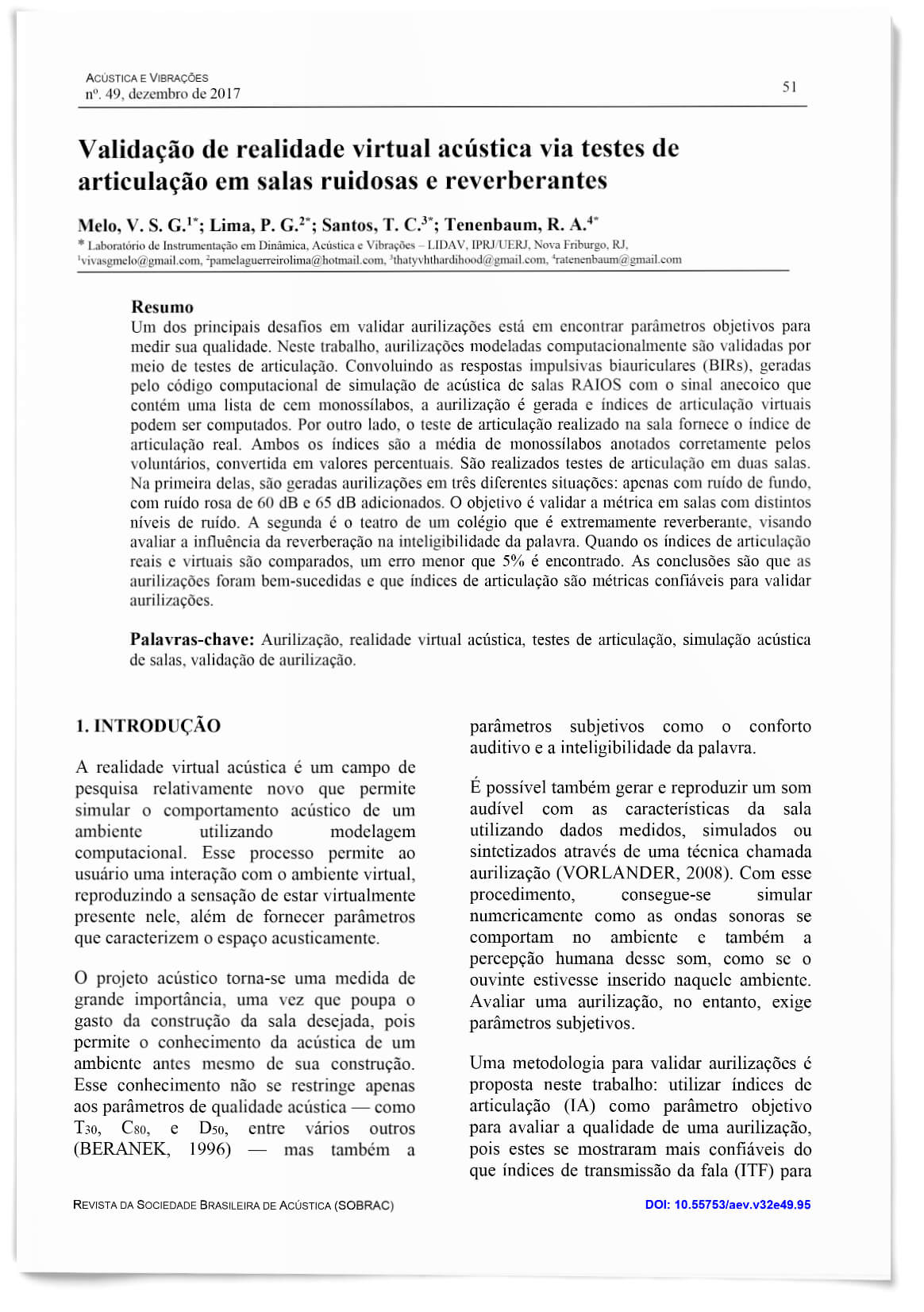Validation of acoustic virtual reality via articulation tests in noisy and reverberating rooms
DOI:
https://doi.org/10.55753/aev.v32e49.95Keywords:
auralization, acoustic virtual reality, articulation tests, acoustic simulation of rooms, aurilization validationAbstract
One of the main challenges in validating authorizations is finding objective parameters to measure their quality. In this work, computationally modeled auralizations are validated through articulation tests. By convoluting the binaural impulsive responses (BIRs), generated by the RAIOS room acoustic simulation computational code, with the anechoic signal that contains a list of one hundred monosyllables, auralization is generated and virtual articulation indices can be computed. On the other hand, the articulation test performed in the room gives the actual articulation index. Both indices are the average of monosyllables correctly annotated by the volunteers, converted into percentage values. Articulation tests are carried out in two rooms. In the first one, auralizations are generated in three different situations: with background noise only, with pink noise of 60 dB and 65 dB added. The objective is to validate the metric in rooms with different noise levels. The second is a school theater that is extremely reverberant, aiming to assess the influence of reverberation on the intelligibility of the word. When real and virtual articulation indices are compared, an error less than 5% is found. The conclusions are that the auralizations were successful and that articulation indices are reliable metrics to validate auralizations.
References
BERANEK, L. Concert and Opera Halls: How They Sound. Acoustical Society of America, Woodbury, 1996. doi: 10.1063/1.881889 DOI: https://doi.org/10.1121/1.414882
FELS, J. From children to adults: How binaural cues and ear canal impedances grow. Ph.D. Thesis, Institut für Technische Akustik, Aachen University, Germany, 2008. doi: 10.1121/1.3020603 DOI: https://doi.org/10.1121/1.3020603
ISO. INTERNATIONAL ORGANIZATION FOR STANDARDIZATION. ISO 3382: Acoustics – Measurement of the reverberation time of rooms with reference to others acoustical parameters, 1997.
HARAZKI, Z.; IANCHIS, D.; TIPONUT, T. Generation of the head related transfer functions using artificial neuronal networks. 13th WSEAS International Conference on Circuits, 114–118, 2009.
HODGSON, M.; YORK, N.; YANG, W. and BLISS, M. Comparison of predicted, measured and auralized sound fields with respect to speech intelligibility in classrooms using CATT-Acoustic and Odeon. Acta Acustics united with Acustics, 94(6), 883–890, 2008. doi: 10.3813/AAA.918106 DOI: https://doi.org/10.3813/AAA.918106
MELO, V.S.G. Avaliação de inteligibilidade em salas de aula do ensino fundamental a partir de respostas impulsivas biauriculares obtidas com cabeça artificial de dimensões infantis. Tese de Doutorado em Engenharia Mecânica – COPPE, Universidade Federal do Rio de Janeiro, Rio de Janeiro, 2012.
MELO, V.S.G.; TENENBAUM, R.A.; NARANJO, J.F.L. A New Approach to Validate Computer Modeling auralizations by Using Articulation Indexes. Acústica e Vibrações, V. 46, 1–8, 2014.
MÜLLER, S. Medir o STI. Anais do seminário de música, ciência e tecnologia, 2, São Paulo, 2005.
MÜLLER, S. Monkey Forest User Manual. Aachen, Germany, Audio & Acoustics Consulting, 2008.
NARANJO, J.F.L.; TENENBAUM, R.A.; TORRES, J.C.B. Acoustic quality parameters used for error evaluation of neural networks modeling for HRIRs applied to escape training in blind conditions. Int. Rev. Chem. Eng., V. 5(6), 394–399, 2013. DOI: https://doi.org/10.15866/ireche.v5i6.6947
PENG, J. Feasibility of subjective speech intelligibility assessment based on auralization. Applied Acoustics, 66, 591–601, 2005. doi: 10.1016/j.apacoust.2004.08.006 DOI: https://doi.org/10.1016/j.apacoust.2004.08.006
SANTOS, T.C. Validação de realidade virtual acústica via testes de articulação com ruído. Trabalho de Conclusão de Curso de Graduação em Engenharia Mecânica – UERJ, Instituto Politécnico, Universidade do Estado do Rio de Janeiro, 2016.
SANTOS, L.R. Validação de realidade virtual acústica via testes de articulação. Trabalho de ConclusãoCurso de Graduação em Engenharia Mecânica – UERJ, Instituto Politécnico, Universidade do Estado do Rio de Janeiro, 2015.
TENENBAUM, R.A.; CAMILO, T.S.; TORRES, J.C.B. and GERGES, S.N.Y. Hybrid method for numerical simulation of room acoustics with auralization: Part 1 – Theoretical and numerical aspects. J. Braz. Soc. Mech. Sci. & Eng., V. 29(2), 211–221, 2007a. doi: 10.1590/S1678-58782007000200012 DOI: https://doi.org/10.1590/S1678-58782007000200012
TENENBAUM, R.A.; CAMILO, T.S.; TORRES, J.C.B. and STUTZ, L.T. Hybrid Method for numerical simulation of room acoustics: Part 2 – Validation of the computational code RAIOS 3. J. Braz. Soc. Mech. Sci. & Eng., V. 29(2), 222–231, 2007b. doi: 10.1590/S1678-58782007000200013 DOI: https://doi.org/10.1590/S1678-58782007000200013
TENENBAUM, R.A.; MELO, V.S.G. and MUSAFIR, R.E. Intelligibility assessment in elementary school classrooms from binaural room impulse responses measured with a childlike dummy head. Applied Acoustics, Vol. 74, 1436–1447, 2013. doi: 10.1016/j.apacoust.2013.06.005 DOI: https://doi.org/10.1016/j.apacoust.2013.06.005
TENENBAUM, R.A.; MELO, V.S.G. and NARANJO, J.F.L. Virtual reality: A new approach to validate computer modeling auralizations by using articulation indexes. In: Cipresso, P. and Serino, S. Virtual Reality: Technologies, Medical Applications and Challenges, Nova Publishers, New York, 2015. doi: 10.1016/j.apacoust.2017.09.025 DOI: https://doi.org/10.1016/j.apacoust.2017.09.025
VORLANDER, M. Auralization: Fundamentals of Acoustics, Modelling, Simulation, Algorithms and Acoustic Virtual Reality. Springer, Berlin, 2008. doi: 10.1121/1.2908264 DOI: https://doi.org/10.1121/1.2908264
YANG, W.; HODGSON, M. Validation of the auralization technique: Comparative speech intelligibility tests in real virtual classrooms. Acta Acustica united with Acustica, 93(6), 991–999, 2007.

Downloads
Published
How to Cite
Issue
Section
License
Copyright (c) 2017 Acústica e Vibrações

This work is licensed under a Creative Commons Attribution-NonCommercial-ShareAlike 4.0 International License.




